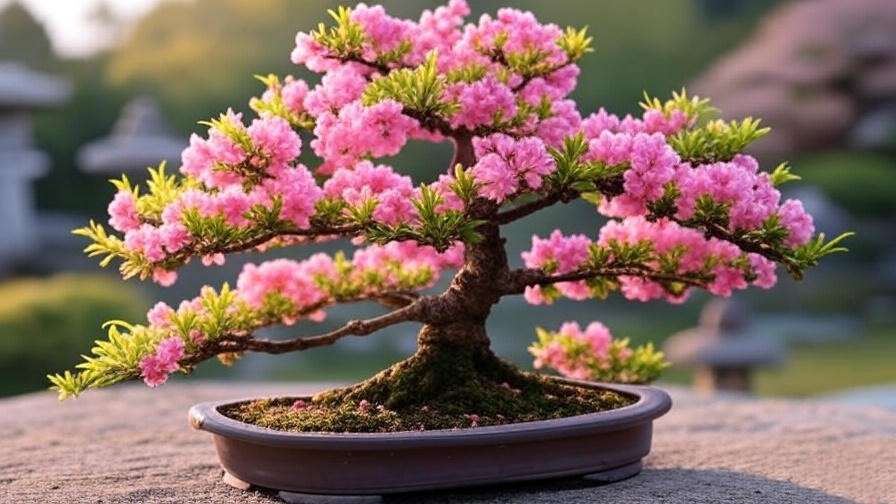Imagine a miniature cherry blossom bonsai tree in full bloom, its delicate pink petals cascading over a gnarled trunk, bringing the fleeting beauty of spring into your home. This breathtaking sight, steeped in Japanese tradition, captivates plant enthusiasts worldwide. Growing a cherry blossom bonsai tree is both an art and a journey, blending patience with nature’s elegance. Whether you’re a beginner or a seasoned bonsai grower, this guide offers expert-backed techniques to ensure vibrant blooms and a thriving tree. With over a decade of bonsai cultivation experience and insights from Japanese horticultural traditions, we’ll walk you through every step to master cherry blossom bonsai care. Ready to create your own living masterpiece? Let’s dive in!
1. Understanding the Cherry Blossom Bonsai Tree 🌳
1.1 What Is a Cherry Blossom Bonsai?
A cherry blossom bonsai is a miniature version of the iconic Prunus serrulata or related species, carefully cultivated to mimic the grandeur of full-sized cherry trees. Known as sakura in Japan, these bonsai embody the cultural symbol of renewal and impermanence. Their delicate pink or white blooms and lush green foliage make them a favorite among bonsai enthusiasts. Popular varieties for bonsai include Yoshino (Prunus × yedoensis) for its soft white flowers and Kwanzan (Prunus serrulata ‘Kanzan’) for its vibrant double-pink blooms. Each tree is a unique work of art, shaped through meticulous care.
1.2 Why Choose a Cherry Blossom Bonsai?
The allure of a cherry blossom bonsai lies in its stunning aesthetics and emotional resonance. In spring, the tree bursts into a spectacle of blooms, transforming any space into a serene oasis. Beyond beauty, it carries deep cultural significance, representing life’s fleeting moments—a reminder to cherish the present. For plant lovers, cultivating a cherry blossom bonsai offers a rewarding challenge, blending horticultural skill with creative expression. It’s perfect for those who seek a meditative hobby and a connection to nature.
Expert Insight: “Caring for a cherry blossom bonsai is like nurturing a piece of living poetry,” says Hiroshi Tanaka, a third-generation bonsai master from Kyoto. “It teaches patience and respect for nature’s rhythms.”
2. Getting Started: Choosing Your Cherry Blossom Bonsai 🌱
2.1 Selecting a Healthy Tree
Choosing a healthy cherry blossom bonsai is the foundation of success. When shopping at nurseries or online, look for a tree with a sturdy trunk, well-proportioned branches, and a robust root system. Healthy leaves should be vibrant, without spots or wilting. Avoid trees with signs of pests (like webbing or sticky residue) or poor grafting, such as uneven bark transitions. Reputable sources like local bonsai clubs or specialized retailers ensure quality. If possible, inspect the tree in person to assess its vitality.
Checklist for Evaluating Bonsai Health:
- Trunk: Thick, tapered, with no cracks or scars.
- Branches: Evenly spaced, with no dead or brittle ends.
- Leaves: Bright, uniform color, free from yellowing or spots.
- Roots: Firm, not mushy, with no foul odor.
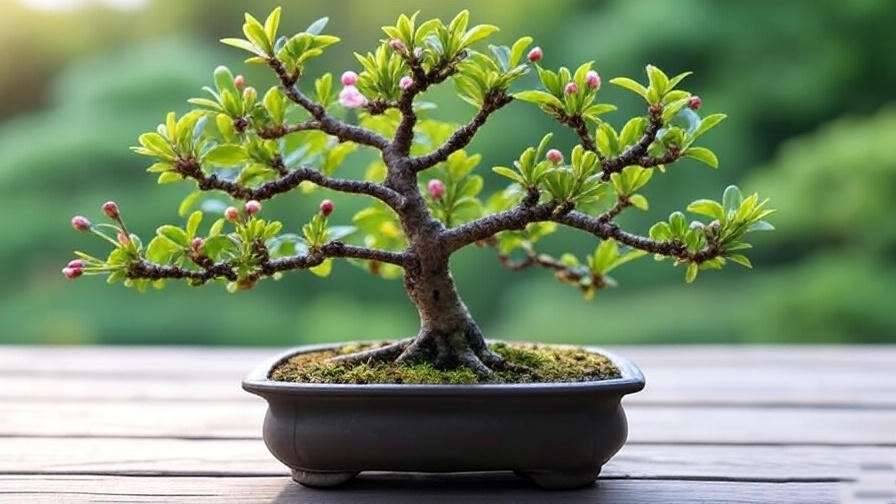
2.2 Starting from Scratch vs. Buying Pre-Trained
You can start your cherry blossom bonsai journey in two ways: growing from seed or cuttings, or purchasing a pre-trained tree. Seeds or cuttings offer a budget-friendly option but require 5–10 years to develop into a blooming bonsai, demanding patience and skill. Pre-trained bonsai, while more expensive, provide instant gratification and are ideal for beginners. Nurseries often sell trees aged 3–5 years, already shaped for aesthetic appeal. Consider your time, expertise, and goals when deciding.
Tip: If starting from seed, choose fresh seeds from a reputable supplier and stratify them (cold treatment) for 60–90 days to boost germination.
3. Essential Care Requirements for Cherry Blossom Bonsai 🌞
3.1 Light and Location
Cherry blossom bonsai thrive in bright, indirect sunlight for at least 6 hours daily. Outdoors, place them in a spot with morning sun and afternoon shade to prevent leaf scorch. Indoors, a south-facing window with filtered light works, but supplement with grow lights in low-light climates. Rotate the tree weekly for even growth. In winter, protect from frost by moving to a sheltered area or using a cold frame in colder regions (below 20°F or -6°C).
3.2 Watering Needs
Proper watering is critical for cherry blossom bonsai. Keep the soil consistently moist but never waterlogged. Water when the top 1/2 inch of soil feels dry, typically every 1–2 days in warm weather. Use a watering can with a fine nozzle to avoid disturbing the soil. Overwatering leads to root rot (yellowing leaves, soggy soil), while underwatering causes wilting or leaf drop. For best results, use rainwater or filtered water to avoid mineral buildup.
Pro Tip: Check drainage holes regularly to ensure proper water flow.
3.3 Soil and Potting
A well-draining soil mix is essential for cherry blossom bonsai. A blend of 50% akadama, 25% pumice, and 25% lava rock provides optimal drainage and aeration. Repot young trees (under 5 years) every 1–2 years in early spring, before new growth begins. Mature trees need repotting every 3–5 years. Choose a shallow bonsai pot with drainage holes, sized to allow 1–2 inches of space around the root ball. Traditional glazed pots in earthy tones complement the tree’s aesthetic.
Step-by-Step Repotting Guide:
- Gently remove the tree from its pot.
- Trim 1/3 of the root mass, focusing on tangled or dead roots.
- Place fresh soil mix in the pot, position the tree, and fill with remaining soil.
- Water thoroughly and place in partial shade for 2 weeks to recover.
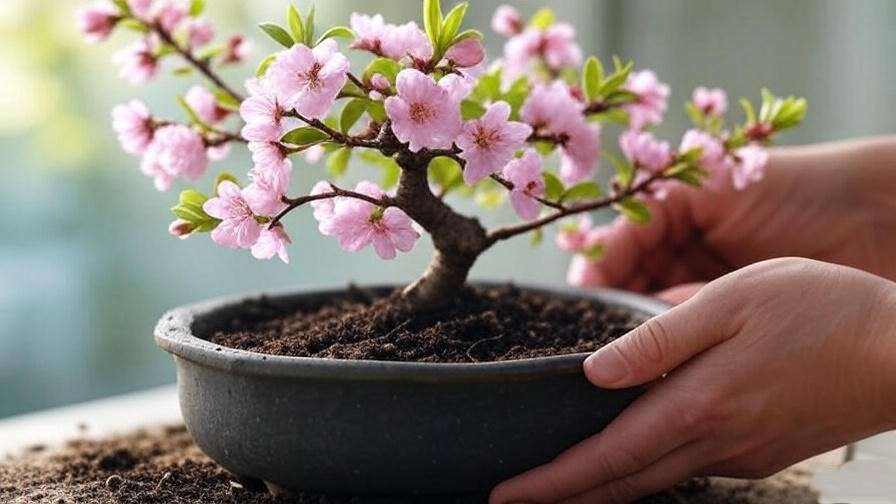
4. Pruning and Shaping for Stunning Aesthetics ✂️
4.1 Pruning Basics
Pruning maintains the cherry blossom bonsai’s shape and encourages healthy growth. Perform structural pruning in late winter or early spring, before buds swell, to define the tree’s form. Maintenance pruning, done throughout the growing season, removes suckers or overcrowded branches. Use sharp, sterilized bonsai shears or concave cutters to make clean cuts. Avoid removing more than 1/3 of the foliage at once to prevent stress.
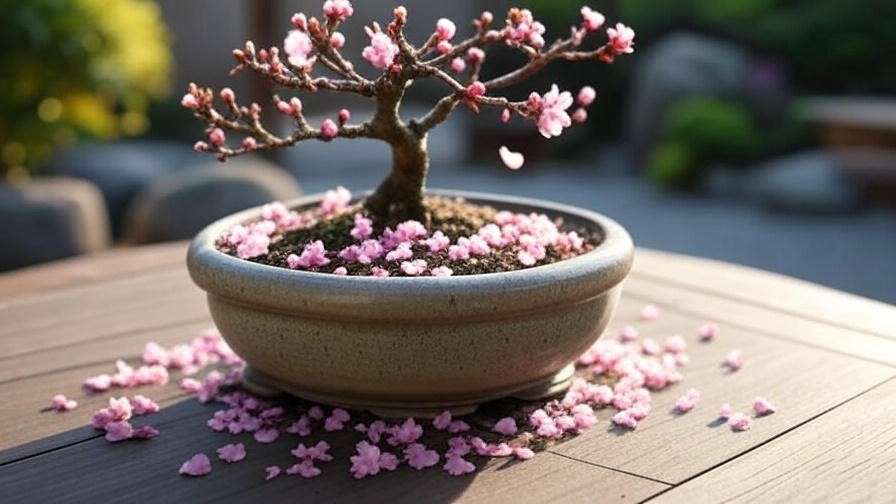
4.2 Wiring for Shape
Wiring allows you to sculpt the bonsai’s branches into elegant forms, such as informal upright or cascade styles. Use anodized aluminum wire, wrapping at a 45-degree angle, and apply gently to avoid damaging bark. Wire in early spring or fall, when branches are flexible, and remove after 2–3 months to prevent scarring. Never wire during blooming to protect delicate flowers.
Expert Caution: Over-pruning or aggressive wiring can reduce blooming. Always prioritize the tree’s health over aesthetics.
5. Encouraging Vibrant Blooms 🌸
5.1 Fertilizing for Growth and Flowering
Fertilizing your cherry blossom bonsai tree is key to promoting lush foliage and vibrant blooms. Use a balanced NPK fertilizer (e.g., 10-10-10) during the growing season (spring to early fall) to support overall health. For blooming, switch to a phosphorus-heavy fertilizer (e.g., 5-10-5) in late summer to encourage flower bud formation. Apply fertilizer monthly, diluting to half-strength to avoid root burn. Organic options like fish emulsion or compost tea are gentle alternatives. During winter dormancy, skip fertilizing to let the tree rest.
Tip: Always water the tree before fertilizing to prevent root damage from concentrated nutrients.
5.2 Blooming Cycle Management
Cherry blossom bonsai typically bloom in spring, with varieties like Yoshino flowering in early spring and Kwanzan in mid-to-late spring. To maximize blooms, ensure the tree experiences a proper chilling period (32–45°F or 0–7°C) for 6–8 weeks in winter, mimicking its natural dormancy. Stress from overwatering, poor light, or extreme temperatures can inhibit flowering. If blooms are sparse, check for nutrient deficiencies or improper pruning. Regular care and patience are essential, as young trees may take 3–5 years to produce consistent flowers.
Troubleshooting: If your bonsai isn’t blooming, consider these fixes:
- Increase chilling: Move the tree to a cooler, protected area in winter.
- Adjust pruning: Avoid heavy pruning during bud formation.
- Check light: Ensure adequate sunlight for energy production.
Case Study: Emma, a bonsai enthusiast from Oregon, revived her non-blooming Kwanzan bonsai by moving it to a sheltered porch for winter chilling and using a phosphorus-rich fertilizer. Within two seasons, her tree produced vibrant double-pink blooms.
6. Seasonal Care for Long-Term Health 🍂
6.1 Spring and Summer Care
Spring is the cherry blossom bonsai’s peak season, with active growth and blooming. Water regularly to keep soil moist, especially during flowering. Fertilize monthly and monitor for pests like aphids, which thrive in warm weather. Summer requires vigilance against heat stress—provide afternoon shade and mist leaves to boost humidity in dry climates. Pinch back new shoots to maintain shape and encourage dense foliage. Ensure good airflow to prevent fungal issues.
6.2 Fall and Winter Care
In fall, reduce watering as growth slows, and stop fertilizing to prepare for dormancy. Remove fallen leaves from the soil surface to prevent mold. In winter, protect your bonsai from freezing temperatures (below 20°F or -6°C) by moving it to an unheated garage, cold frame, or insulated outdoor area. For indoor bonsai, maintain temperatures between 35–50°F (2–10°C) and avoid placing near heat sources. Water sparingly, just enough to prevent soil from drying out completely.
Seasonal Care Calendar:
- Spring: Water daily, fertilize monthly, prune lightly, monitor blooms.
- Summer: Shade from intense sun, mist for humidity, check for pests.
- Fall: Reduce watering, clear debris, prepare for dormancy.
- Winter: Protect from frost, water minimally, ensure chilling period.
7. Common Problems and Solutions 🐛
7.1 Pests and Diseases
Cherry blossom bonsai are susceptible to pests like aphids, spider mites, and scale insects, which feed on sap and weaken the tree. Fungal infections, such as powdery mildew or root rot, can occur in humid or poorly drained conditions. Inspect your tree weekly for signs like sticky residue, webbing, or discolored leaves. Treat pests with neem oil or insecticidal soap, applied in the evening to avoid leaf burn. For fungi, use a copper-based fungicide and improve airflow. Prevent issues by maintaining hygiene—sterilize tools and quarantine new plants.
Prevention Tips:
- Ensure proper drainage to avoid root rot.
- Space branches to improve ventilation.
- Remove dead leaves or debris promptly.
7.2 Environmental Stress
Environmental stress manifests as yellowing leaves, wilting, or dropped buds. Common causes include:
- Overwatering: Soggy soil suffocates roots. Solution: Reduce watering and check drainage.
- Underwatering: Dry soil causes wilting. Solution: Water consistently and monitor soil moisture.
- Light Issues: Too little light stunts growth; too much burns leaves. Solution: Adjust to 6+ hours of indirect sunlight.
- Temperature Extremes: Frost or heat stress damages buds. Solution: Protect with shade cloth or winter coverings.
Pro Tip: Create a humidity tray by placing the bonsai pot on a tray of pebbles filled with water (not touching the pot) to boost moisture for indoor trees.
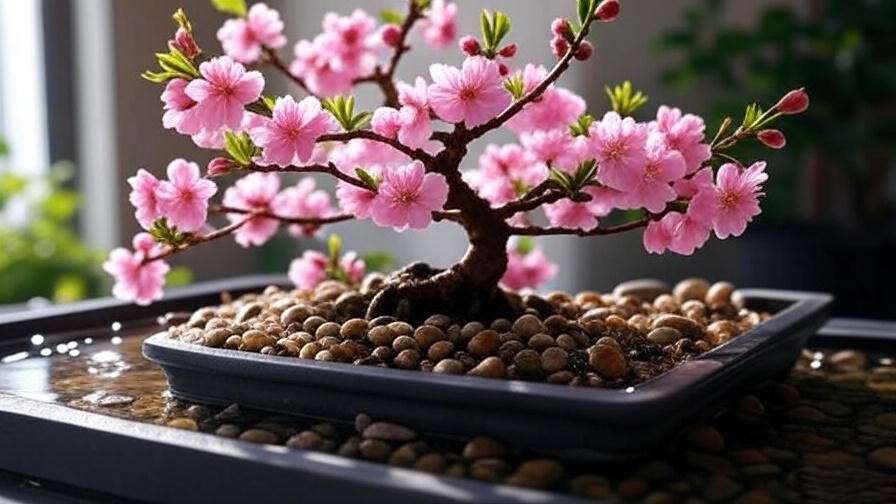
8. Advanced Techniques for Bonsai Enthusiasts 🌟
8.1 Grafting for Unique Features
Grafting enhances your cherry blossom bonsai by adding desirable traits, such as vibrant blooms from a different variety. For example, grafting a Kwanzan scion onto a Yoshino rootstock can create a tree with striking pink flowers. Use a cleft or whip graft in early spring, ensuring clean cuts and secure binding with grafting tape. Success requires patience, as grafts take 6–12 months to fully integrate. Sterilize tools to prevent infection, and monitor for signs of rejection (e.g., wilting scion).
8.2 Propagating Your Own Bonsai
Propagating a cherry blossom bonsai from scratch is a rewarding challenge. Methods include:
- Cuttings: Take 4–6-inch semi-hardwood cuttings in summer, treat with rooting hormone, and plant in a moist sand-peat mix. Roots form in 6–8 weeks.
- Air Layering: Encourage root growth on a branch while still attached, then separate after 2–3 months.
- Seeds: Stratify seeds for 60–90 days, plant in spring, and nurture for 5+ years to reach bonsai size.
Each method requires dedication, but air layering offers the fastest results for beginners. Propagated trees allow you to shape your bonsai from the ground up, fostering a deeper connection.
Expert Insight: A 2023 study from the Japanese Bonsai Association found that air-layered cherry blossom bonsai retain the genetic vigor of their parent tree, producing blooms comparable to nursery stock.
9. Displaying Your Cherry Blossom Bonsai 🎨
A well-displayed cherry blossom bonsai enhances its beauty and elevates your space. Place it on a wooden stand or slate at eye level to highlight its form. Pair with accent plants like moss or small ferns to mimic a natural setting. In spring, display in a traditional tokonoma (alcove) for a Japanese-inspired aesthetic, or use seasonal decor like stone lanterns to complement blooms. For photography, use natural light and a neutral background to capture the tree’s delicate details, perfect for sharing on social media or bonsai forums.
Inspiration: At the 2024 Tokyo Bonsai Exhibition, a 50-year-old Yoshino cherry blossom bonsai won “Best in Show” for its elegant cascade style, displayed with a minimalist stone accent.
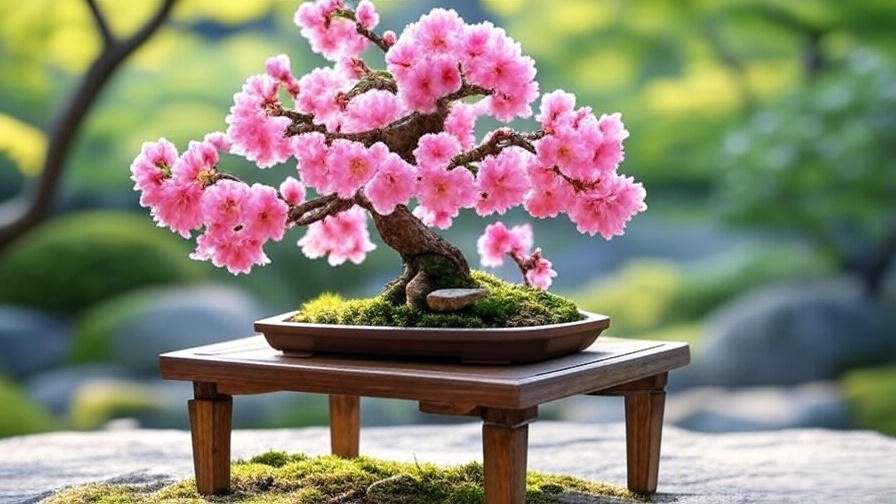
10. FAQs About Cherry Blossom Bonsai Care ❓
- How long does it take for a cherry blossom bonsai to bloom?
Young trees take 3–5 years to bloom consistently. Ensure proper chilling and nutrition to encourage flowering. - Can cherry blossom bonsai thrive indoors year-round?
They prefer outdoor conditions with seasonal changes but can survive indoors with bright light and cool winter temperatures. - What’s the best way to protect my bonsai from pests?
Use neem oil, maintain hygiene, and inspect regularly to catch infestations early. - How often should I repot my cherry blossom bonsai?
Repot young trees every 1–2 years, mature trees every 3–5 years, in early spring. - Why are my bonsai’s leaves turning yellow?
Yellowing often indicates overwatering, poor drainage, or nutrient deficiency. Adjust care and test soil.
11. Conclusion: Your Journey with Cherry Blossom Bonsai 🌼
Cultivating a cherry blossom bonsai tree is a journey of patience, creativity, and connection to nature. From selecting a healthy tree to mastering pruning and blooming techniques, each step brings you closer to a living work of art. With the expert tips in this guide—rooted in decades of bonsai tradition and modern horticultural science—you’re equipped to grow a stunning bonsai that blooms vibrantly each spring. Embrace the challenge, savor the process, and let your cherry blossom bonsai inspire awe. Share your progress in the comments or on social media, and explore our related articles on bonsai pruning or flowering plant care for more insights. Happy growing! 🌸

